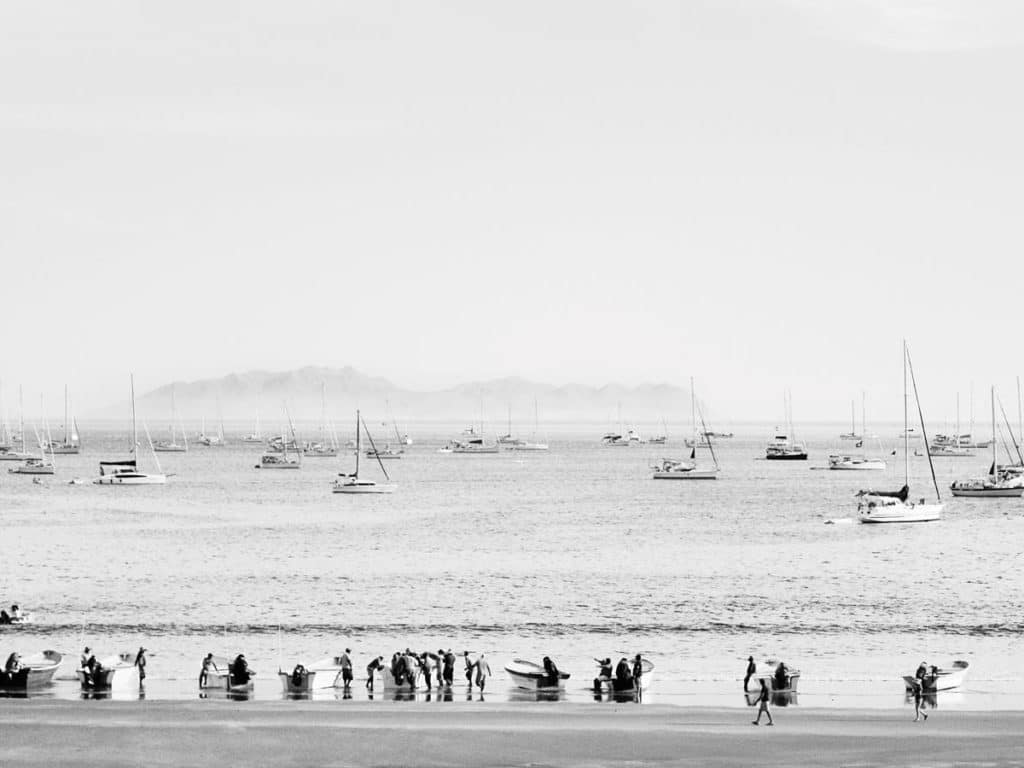
It was still quite dark when I heard one outboard and then another start. Meriwether had been adrift on calm seas for the past couple of hours, and I’d slept soundly after coming off my 2300-to-0100 watch. Tempted as I was to stay wrapped in my sleeping bag, I knew as soon as I heard the engines clunk into gear it was going to get noisy fast. Besides, it was showtime. We were about to make our first landfall along Mexico’s Baja coast, and I didn’t want to miss a minute of it.
On deck, Steve Price, Meriwether‘s owner, was at the wheel of the Seawind 1190 Sport catamaran, and he was itching to get going. Up ahead, a handful of boats were motoring, killing time and waiting for dawn before tackling the entrance to Bahia Tortuga, or Turtle Bay as we Yanks would say. To the north, a half-dozen more steaming lights were coming our way. Though we’d seen few other boats in the past 24 hours, after nearly three days of sailing and 360 nautical miles, it looked as though we were destined to be part of a Baja Ha-Ha parade into the anchorage.
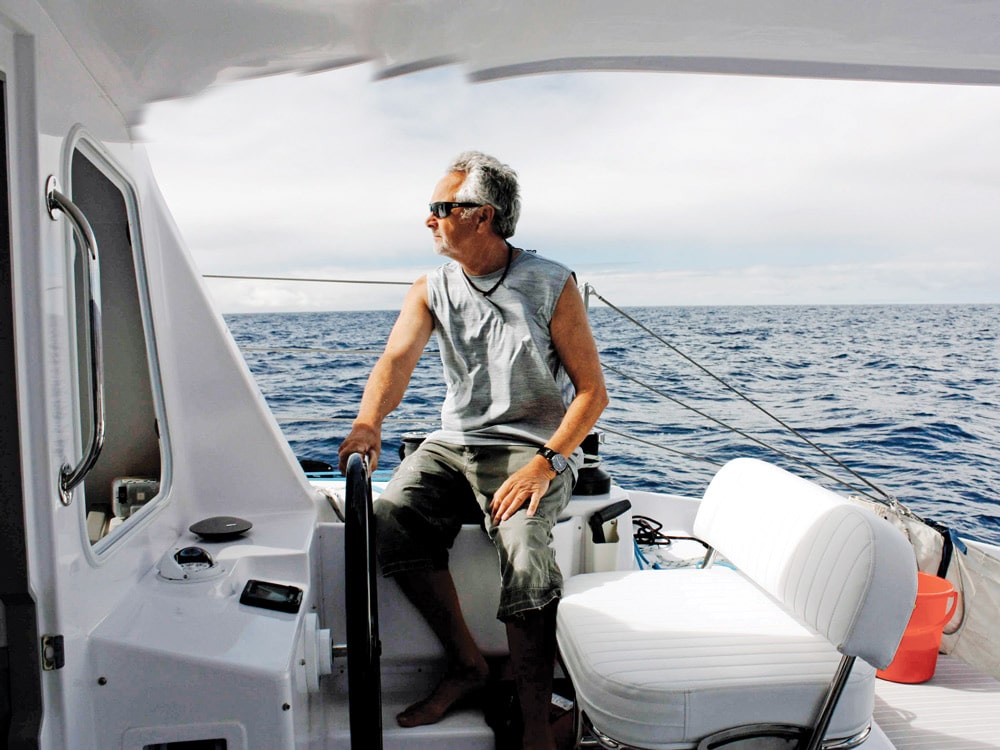
Soon, crewmates Randy Brown and Kurt Jerman were on deck. Though overcast, the sky brightened as we closed on land. Inside the bay, we found scores of sailboats already anchored — so much for being in the vanguard of this gypsy troupe. We dropped the hook near shore in front of a run-down-looking factory just in time to check in on the morning radio net and grill up a breakfast of Spam and eggs — fine dining, indeed, after our high-seas wake-up meals of biscotti, yogurt, cereal and java.
This little West Coast adventure actually began a year earlier on the docks of the U.S. Sailboat Show in Annapolis, Maryland, where I’d run into Kurt, a California Seawind dealer. A customer who wanted a sporty cat to keep at his vacation home in Loreto, Mexico, on the Sea of Cortez, was going to take delivery of an 1190 in San Diego and then, in the fall, join the annual exodus of Pacific sailors headed south. Did I want to join them?
You bet I did. To get to see every brown, bush-covered sandy mile of Baja, from San Diego to Cabo San Lucas, was just too tempting to pass up.
Last fall’s rally was the 24th Baja Ha-Ha. By the time the skippers meeting convened in the parking lot of the West Marine store in San Diego, the fleet numbered 131 boats, carrying a total of 466 crew, led, as always, by Grand Pooh-bah Richard Spindler and chosen friends aboard his long-legged catamaran Profligate. Richard, now retired as publisher of the popular West Coast sailing magazine Latitude 38, founded the rally while still at the publication.
It was Sunday, October 29, and the store was a beehive of last-minute shoppers, many decked out in their Halloween finery for the afternoon’s costume party and barbecue. Outside, Richard called out each boat’s name and introduced the captain. Then, formalities completed, most of the crowd milled around waiting for the party to begin.
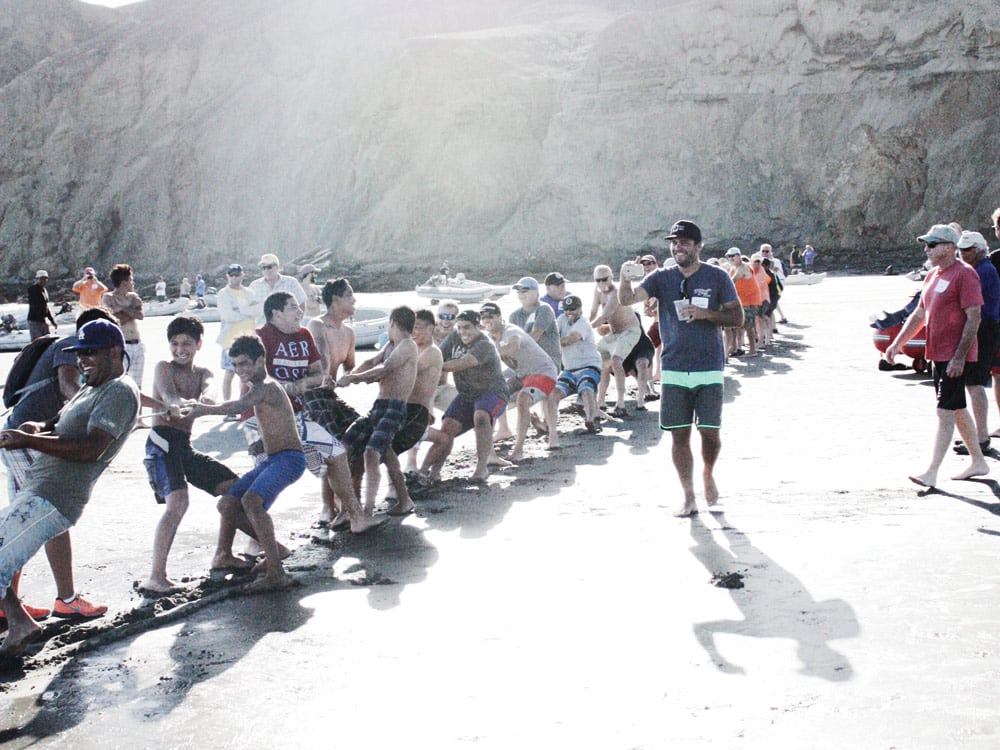
Team Meriwether, however, had a few things left on the to-do list, such as installing new rudders, firing up the electronics and taking the cat out for a short shakedown sail.
Steve was a retired HVAC mechanic who hailed from Lake Sakakawea, North Dakota, where he’d been an avid Corsair trimaran sailor. He’d only owned Meriwether a short while, and his time aboard had consisted primarily of a saltwater sailing lesson/cruise to Catalina Island with Randy a few weeks earlier. During the trip, both rudders had developed problems, and a new pair had been delivered. Replacing them was simple since they slid into cassettes on each transom, but once in place, it was apparent why they’d failed initially: There was just a bit too much wiggle room that caused wear. It was nothing, though, that a little padding couldn’t fix in a jiffy.
As its name implies, the 1190 Sport was intended to be a lively sailer. Meriwether had upgraded sails, including a flat-top main and cruising spinnaker. Rather than heavy inboard engines and saildrives to drag through the water, it was outfitted with a pair of electric-tilt outboards. The plan was to leave them raised most of the time and let a steady northwest wind blow us on our merry way. Mother Nature, though, had other ideas.
M onday dawned gray and drizzly. We joined the Ha-Ha parade and motorsailed by numerous tourist boats and San Diego fireboats throwing up plumes of spray on our way to Point Loma and the start. What a sight to behold. At opposite ends of the spectrum, the fleet included Tiny Dancer, a Dana 27, and Emma, a Deerfoot 62. There were 13 multihulls sailing south, including the 63-foot Profligate, of course, and Seabird, a diminutive F-27 Corsair, captained by 74-year-old Richard Holden. As we approached the point, as if on cue, an aircraft carrier steamed into the harbor, right in the thick of things.
And then, precisely at 1100, we were off. Next stop, Turtle Bay, 360 miles down the line. Like most of the rest of the fleet, we reached west to clear Islas Los Coronados, just across the Mexico border. From there, our course kept us within eyesight of the coast but hopefully far enough at sea to find a steady breeze.
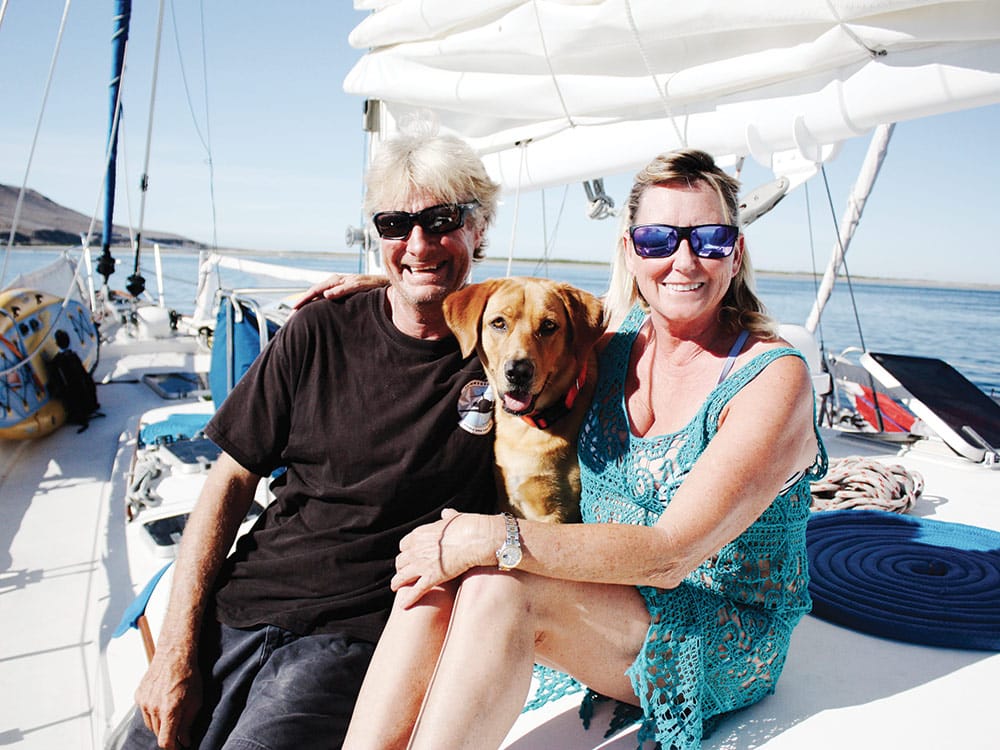
With nothing much else to do, it was time to fish. The effort of setting up a line and tending it was rewarded late in the afternoon when Kurt hauled in a bonito and ensured us there’d be fish tacos for dinner.
Midafternoon, we settled into a two-hour-on watch schedule. Randy had been on the wheel for a spell, so he handed things off to me at 1500. Kurt drew 1700 to 1900, Steve 1900 to 2100, then Randy started it all over again. I like sailing at night, so having the 2300 to 0100 slot suited me just fine.
It wasn’t long before the breeze puttered out, and over the radio the Grand Pooh-bah declared we were all cleared to motor. The Ha-Ha is not a race, but with a prize ceremony at its end, participants were encouraged to keep track of the start and finish time for each of the rally’s three legs, and to record how much motoring and sailing was done. Steve fired up one outboard; we’d run it for a couple of hours, and then switch to the other if need be. Who knew then that this would be a remarkably windless year? It turned out we could have swapped engines each day and still have kept the hour meters in sync.
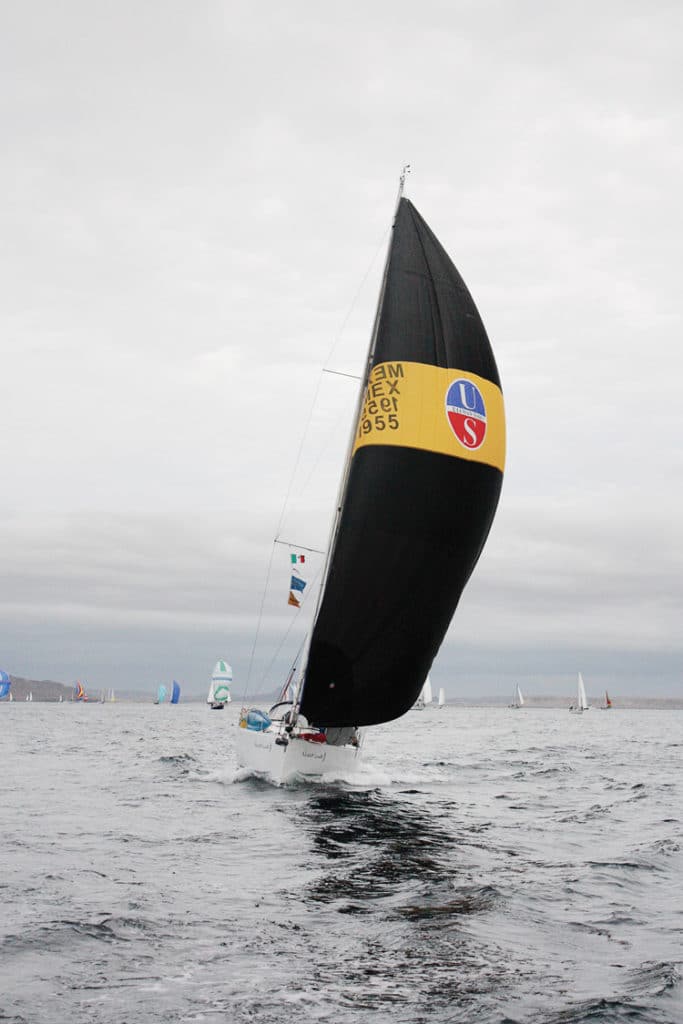
As luck would have it, the starboard engine was running when I retreated for a nap in my aft cabin on that side of the boat. Mounted on the other side of the bulkhead that was at the foot of my bunk, it was loud enough for sleep not to be an option. On this three-cabin cat, Randy and Steve both had forward berths and Kurt took his siestas on the saloon’s couch, so they weren’t nearly as bothered by the din. The fix was obvious: From that time on, mercifully, the port engine was run while I snoozed.
One benefit of sailing in the company of a lot of boats is that you’re never far from help. The downside is that at night, you’re never far from a possible collision. To keep warm that first night, I kept moving in circles. I checked the chart plotter, its screen cluttered with AIS targets; climbed up on deck to get a look around; then stepped into the relative warmth of the saloon for a minute or two before revisiting the chart plotter again. Far astern, the sky above San Diego and Tijuana glowed red. To the east, the lights of Ensenada looked like a sprawling amusement park’s roller coaster. Toward the end of my watch, three times a vessel approached from astern, came quite close, then motored off in a big circle before eventually disappearing into the night.
Strange.
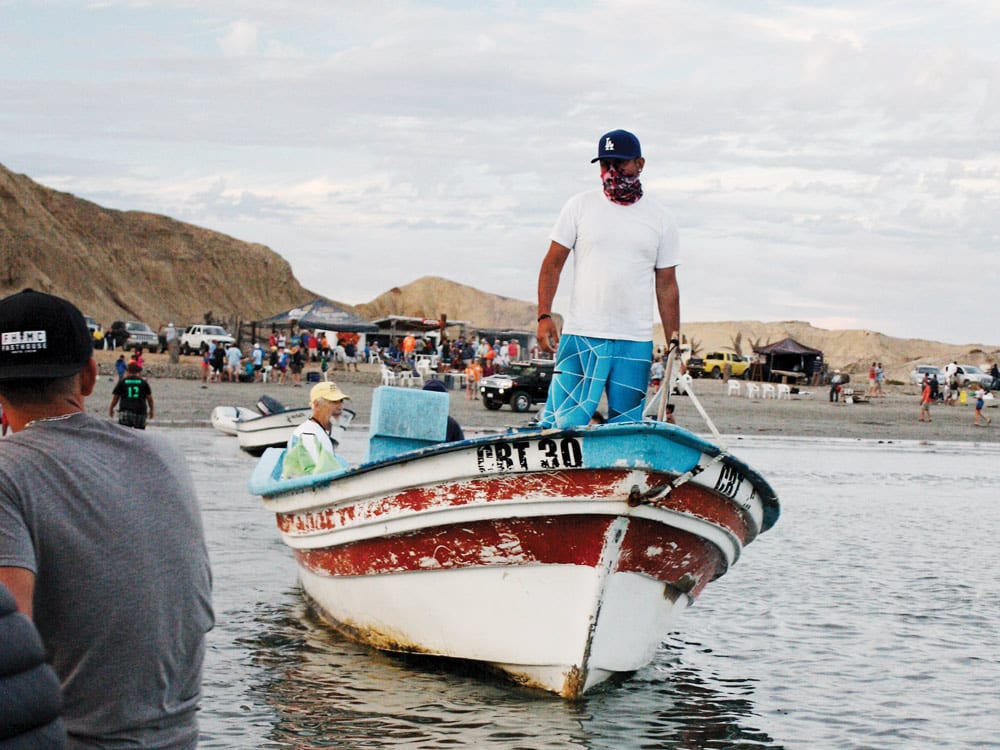
Tuesday brought more of the same. I came on deck at 0700 to find the mountainous shore shrouded in clouds. Cabo Colonet, described in the cruising guide as a large nose on the coast, was abeam. We were about a third of the way to Turtle Bay. Our route for the day took us in a straight line across Bahia Vizcaino and 30 or 40 miles offshore for a time.
Just before 1500, I was sitting in the saloon when a breeze from astern rustled papers on the table. Like that, we turned off the outboard, eased out the main, hoisted the spinnaker and sailed. My two hours on the wheel were glorious. For a while, I set the autopilot and trimmed the kite. Then I locked off the sheet on the self-tailing winch and steered. I was like a kid in a toyshop, and the time flew by. Near sunset, we whipped up a stir-fry of chicken, onions, broccoli and rice on the Seawind’s stainless-steel grill and ate like kings.
And then, as quick as it had picked up, the wind died. It was another long night of motoring.
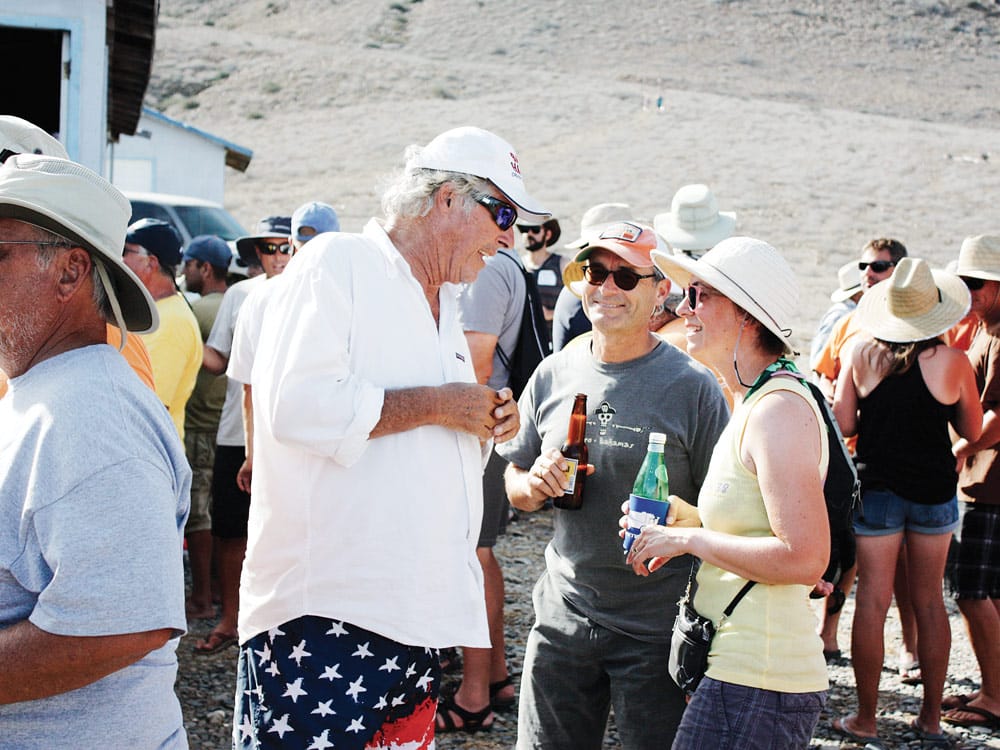
On Wednesday morning, Isla Cedros lay 30 miles ahead. Decision time. We could sail past it and arrive in Turtle Bay in the middle of the night, or anchor off its southern tip, at Cedros Town, then leave at the crack of dawn to cover the last 40 miles in daylight. We liked that idea better, but we’d risk missing the infamous Turtle Bay Ha-Ha softball game with our Mexican hosts. As often happens on a sailboat, we ended up doing something entirely different. We arrived in Cedros Town just after dark and tried to anchor but failed to find good holding on the foul bottom. Defeated, we turned away and immediately snagged a crab pot with one rudder. As soon as Randy cleared that one, we snagged another with the other rudder. It was going to be a long night. We pushed on at half-speed and arrived off Turtle Bay a couple of hours before sunup.
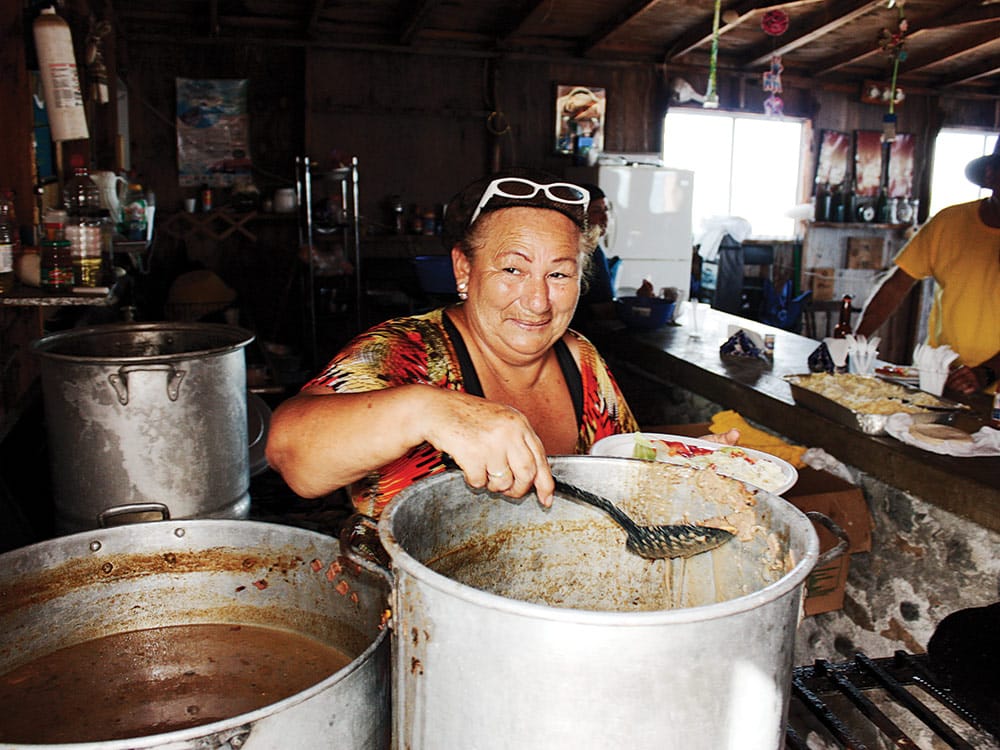
Turtle Bay was tremendous. The town, Puerto San Bartolome, was bustling with sailors. Kurt and I wandered the dirt streets until we found an enormous baseball stadium, where all afternoon, the Grand Pooh-bah, dressed in American-flag shorts, lobbed softballs to a seemingly endless stream of Ha-Ha sailors and Mexicans. Spectacular catches were made. Base running was heroic. The beer flowed, well, like beer.
Waterfront cantinas did a brisk business; everywhere crews from the various boats hoisted refreshments and traded yarns. Then on Friday afternoon, there were more festivities on the beach at the eastern end of the bay. Margaritas, beer and hot dogs were in great abundance. Locals drove their cars and trucks onto the sand and set up parties of their own. And once again, the Ha-Ha women, nearly 100 strong, bested the men in the annual tug of war. It is Baja Ha-Ha lore, in fact, that they’ve never lost.
At 0900 Saturday, right after the morning radio net, nearly the entire fleet flew spinnakers across the start line. Behind us, the bay was empty but for a handful of fishing vessels. The carnival had truly come and gone.
The breeze built all day, and we had to jibe frequently not to stray too far from the rhumb line to Cabo San Lazaro and our next port of call at Bahia Santa Maria, 240 nautical miles south. We sailed day and night, mostly with two reefs in the main and the jib after dark. Without the outboards running to top off the batteries, the solar panels on the cat’s Bimini had a hard time keeping up with the power demands of the autopilot, chart plotter, fridge and freezer. The latter two we turned off in the evening, and we hand-steered most of the time.
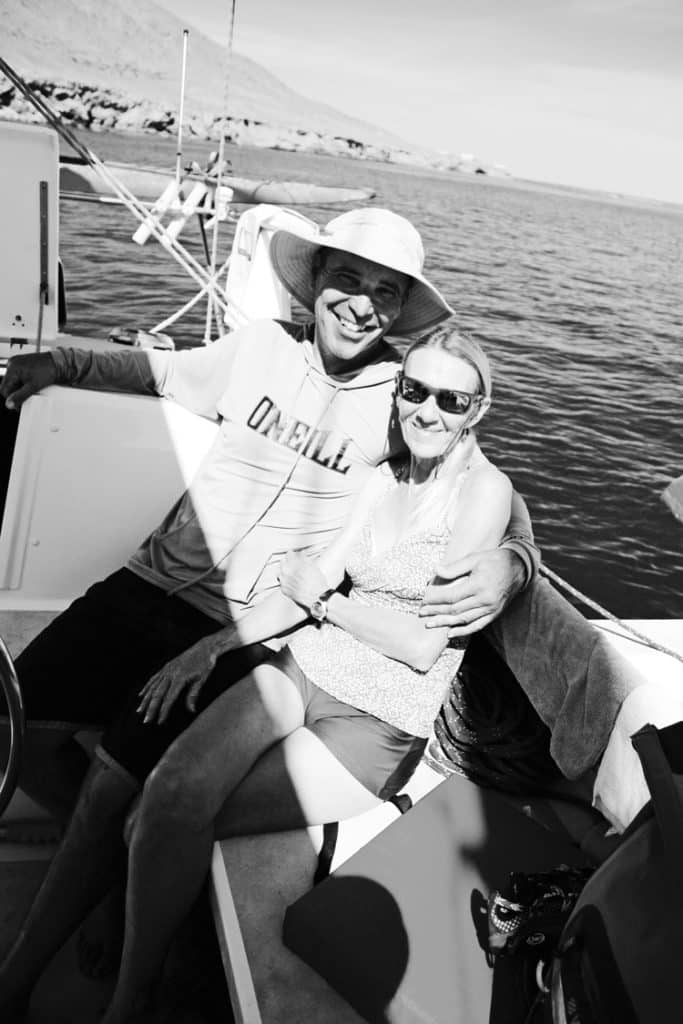
On this part of the coast, the water was sometimes quite deep, maybe 1,000 feet or more; other times it was less than 100. The waves often were confused, but it was wonderful sailing, and at night, the stars were stunning.
Saturday and Sunday were the best sailing days of the trip. The miles rolled by, and life was easy. By Monday’s radio net, though, the two days of brisk conditions had seemingly taken a toll. A few boats reported shredded spinnakers. A dinghy had been lost but recovered by another crew. Watermakers were on the fritz, and a few alternators had gone on holiday. Radio chatter indicated the fleet was ready for a landfall.
Dusk, though, brought a spectacular sight when a nearly still full harvest moon rose slowly out of the mist to the east. The sea sparkled as we tore along, now much closer to the shore as we approached Cabo Lazaro and Punta Hughes. Meriwether had lots of company, and the AIS was invaluable in helping to sort out crossings with other boats in the dark.
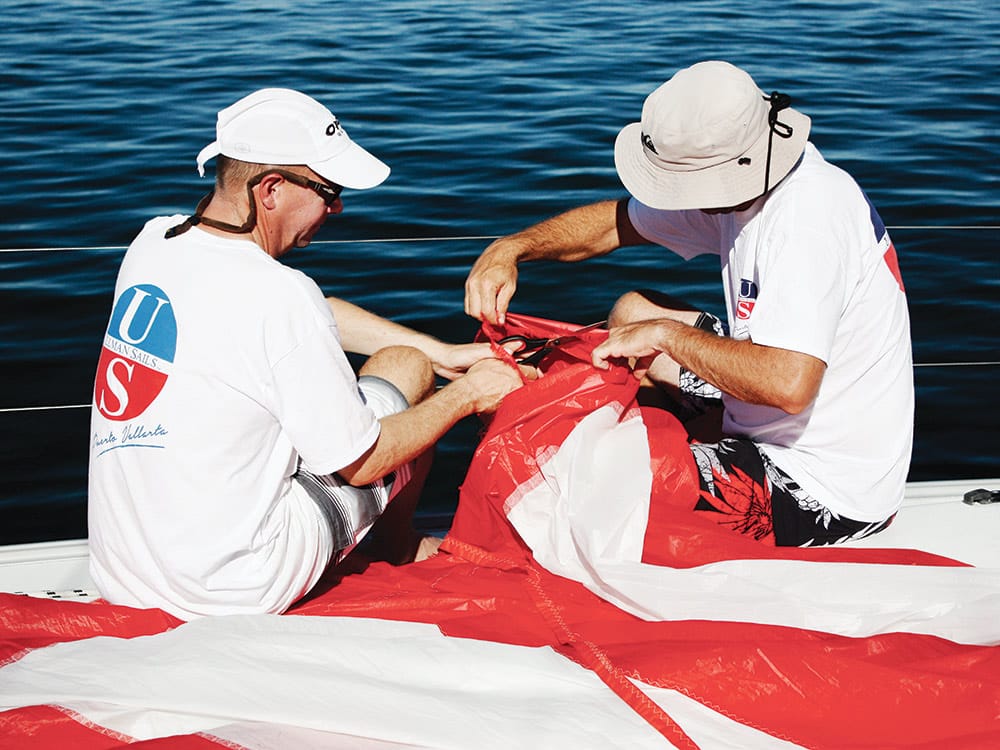
The charm of Bahia Santa Maria is that there’s nothing there but an anchorage on its northern shore. So it was a sight to behold to round the point just before midnight and see a city of anchor lights dancing against the moonlit shore.
Monday, we relaxed. Randy, Kurt and I blew up the inflatable and went for a ride. There was quite a swell running, and we heeded Steve’s request not to try a landing on the beach. Instead, Randy and Kurt swam in the waves while I motored around, watching local fishermen and their pangas bust through the waves and enter the inlet to a mangrove lagoon where there were a handful of fishing shacks hunkered down against the banking. A few Ha-Ha crews tried landing their own inflatables — some successfully, others not so much. It was all good entertainment.
Kurt and I paid a visit to Profligate, where Ha-Ha hats and T-shirts were selling like hotcakes. We stopped by Bonzer, a lovely Chris White trimaran sailed by Michael and Vicki Novak, of Ventura, California. Over the radio, we’d heard that Bonzer had pegged 19 knots on the speedo on the way from Turtle Bay. Michael was a former tug and crane operator; Vicki had just retired as a West Marine store manager. They’d always dreamed of doing the Ha-Ha, and now here they were, sailing fast and having fun.
I also stopped to visit with the Ullman Sails boat, where Chuck Skewes and Sabine Suessmann sat in the cockpit taping a shredded spinnaker back together. It was Chuck’s third Ha-Ha. He was partners at Ullman lofts in California and Puerto Vallarta. He and his shipmates found an enlightened business model in mending the Ha-Ha carnage for free; the rally gets the fleet to Mexico, and later, when sailors arrive in Puerto Vallarta, they naturally visit his loft for replacements. Brilliant.
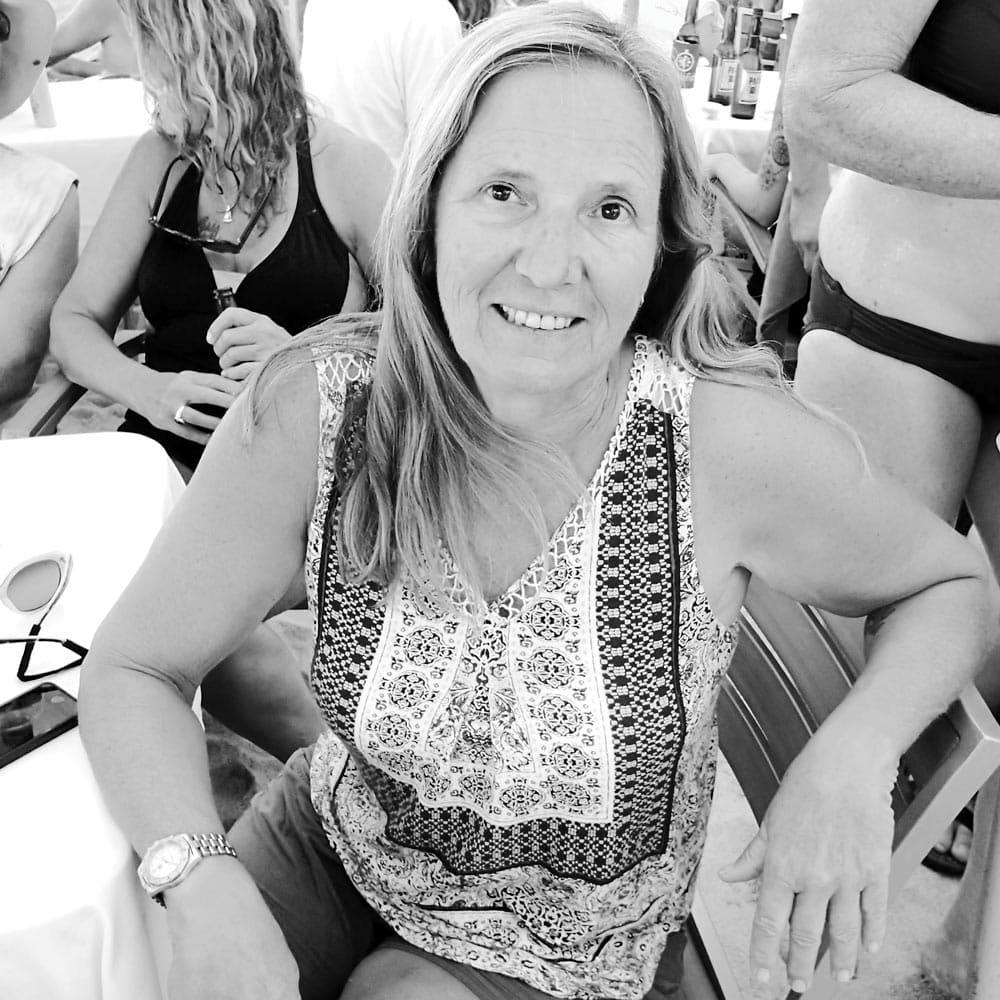
Rafted up with them was Jersey Girl, an Irwin 65 sailed by Kenny Knoll, Donna Cramin and a few friends. Kenny and Donna had sailed south with the 2016 Ha-Ha and spent the ensuing year cruising Mexico. They met wonderful people and had such a great time that they decided to do it all over again. So, a couple of weeks before the start of the 2017 rally, they bashed northward 1,500 nautical miles from the mainland back to San Diego, making it just in time for the skippers meeting.
“I think our families think we’re crazy,” quipped Donna. But, added Kenny, “We have a lot of fun.”
The highlight of the stopover, and perhaps the whole trip, for me anyway, was the gathering the following afternoon on a bluff overlooking the anchorage. Inside a shack on the hillside, local fishermen set up a buffet; outside, tubs were filled with ice and Pacificas. A rock band, the Fantastic Four, traveled over the mountains from La Paz, set up a portable generator and let things rip. It was otherworldly to be in this place, so beautiful and so remote, and yet be surrounded by a few hundred people, all of whom had dreamed of being here — and in countless different ways, made it happen.
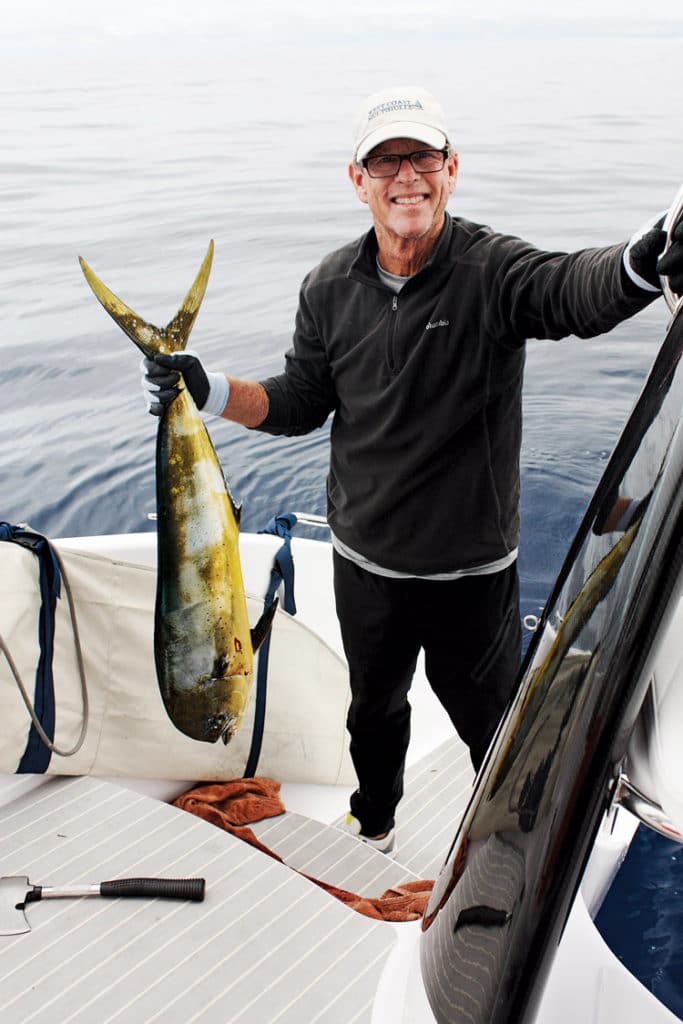
After Bahia Santa Maria, the final 180 miles to Cabo San Lucas seemed anticlimactic. The start the next morning was at 0700. By the time we were at the line, the breeze had died completely and the Pooh-bah proclaimed it time to motor.
Still, it was a spectacular morning. We steamed close to shore, where the surf kicked up a haze along the beach. Further inland, though, it was crisp and clear. Along this stretch of Baja, there was a whole lot of nothing to look at, and I couldn’t get enough of it. A light wind filled in after lunch, and we hoisted the chute, only to be becalmed again a short time later.
We crossed the Tropic of Cancer around midnight, and by sunrise, Cabo Falso was in our sights. There was steady traffic now — fishing boats, yachts, freighters and such — and at the cape, a jarring number of resorts and hotels were under construction on the hillsides. Mile by mile, we returned to civilization. When we anchored around lunchtime in Cabo San Lucas, personal watercraft swarmed like mosquitoes and high-volume drinking contests ashore overwhelmed the senses.
That evening after dinner, Steve and Randy stayed on the boat, but Kurt and I hitched a water-taxi ride to shore. We’d come this far and didn’t want to miss the Can’t Believe We Cheated Death Again dance party at El Squid Roe, a notorious local watering hole taken over annually by the Ha-Ha. There were dancing and tequila and jello shots well into the night. And on Friday, we of course went ashore for the infamous kissing contest, where couples display their passion while rolling in the waves.
But to be honest, I could have skipped all that. For me, the Ha-Ha was about the sailing and the mountains and the 800 or so miles of nearly empty coast we’d just tackled — and about meeting so many sailors for whom this was just the start of a whole new adventure.
Mark Pillsbury is CW’s editor.
The 25th annual Baja Ha-Ha kicks off in San Diego on October 28 and arrives in Cabo San Lucas on November 10. Details can be found at baja-haha.com.
Baja Resources
Planning a passage along Baja’s long coast is a challenge if done while scrolling on a chart plotter. Surprisingly, the West Marine in San Diego was sold out of paper charts. A helpful tip, though, led us around the corner to Seabreeze Books and Charts, owned by Capt. Ann Kinner. Even if you’re not sailing to Cabo, it’s a store worth visiting — and she’s a proprietor who knows her nautical publications! Aboard Meriwether, Steve Price had two useful guidebooks: Mexico Boating Guide (second edition) by Capt. Pat Rains, and Charlie’s Charts of Western Mexico and Baja by Charles and Margo Wood.








